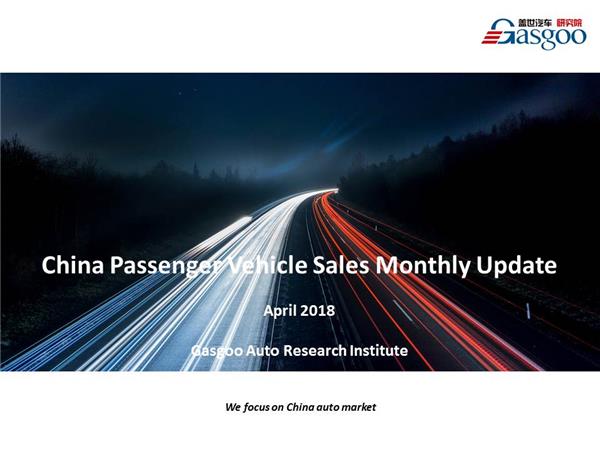A Spell for Small-displacement Engines
Shanghai (ZXZC)-- In April 2018, China's Passenger Vehicle (PV) sales increased by 10.8% year-on-year (YoY) to 1.91mn units, but decreased by 11.7% from 2.16 million in March. YTD PV sales increased to 7.99 mn units from 7.66 million of the same period last year.
A strong rebound happened in production which increased by 13.3% YoY to near 2 million units, and YTD growth of production increased to 1.47% from -1.98% in Q1. The destocking has been finished seemingly, and each OEM is preparing for increasing outputs to meet the sales target.
As predicted, the plug-in electric passenger cars maintain high growth in both sales and production as March. In April, the wholesale of PEVs hit at 73,145 units, soaring by 152.7% YoY, and production hit at 70,957 units, shooting up by 125.8%. The effect of temporary subsidy policy will last to this July, pushing most of EV makers to produce and sell their electric products as many as possible by the deadline. As a result, we see a strong recovery of pure-electric cars from 40,947 in March (+76.3% YoY) to 56,468 units in April (+134.5% YoY), and the ratio of PHEV vs. BEV backs to 1 to 4 as before. The subsidy policy of 2018 is breaking the seasonal pattern of EV market.
The plug-in hybrids also kept strong momentum in sales, reaching at 167 thousands units in April. It appears that nobody can shake the status that BYD crowns the PHEV segment over next few months, but this advantage is being challenged by more and more automakers, like SAIC, GAC, BMW etc., and some coming powerful players, like Toyota and Volkswagen, who have unveiled pretty models lately. Although the sales of BMW’s 5 series PHEV have already been suspended due to design failure, it is still a successful model being one of best-selling products in the market. BMW gives its competitors a clue that consumers never reject products of good quality and smart pricing.
In sedan market, Sylphy replace Lavida as the top in sales, and has been one of best-selling sedans this year. On the other hand, the star model reminds people of Excelle GT/XT which is a previous rival of Lavida. The data reflects the sales of Excelle GT/XT is plunging from last year’s 133,385 units to this year's 88,426 units. The performance is not essentially caused by little change in facelift, but by the powertrain upgrade. SAIC-GM firstly fitted new NGC family (1.0T & 1.3T) onto this car and its wagon derivative, expecting the substantial volume of Excelle family to be a leverage to reduce the corporate average fuel consumption (CAFC). The average wholesale volumes decrease to around 20,000 units per month after 3-month massively distributions. Although strategy is lame, it is also a ‘have-to’ option for this giant automaker because of huge pressures from continuous requirements of emission reduction. The similar problem also confused other companies like Ford, PSA, and VW. Facing the Waterloo of group’s ultra-small-displacement engine(≤ 1.3L), PSA even canceled the EB0TGDI(1.0T) project, and is exporting EB2DT(1.2T) to Europe to improve the rate of capacity utilization. At present, down-sizing has been a global trend but it hasn't been generally accepted by consumers, especially in China.
With the phase out of tax incentives, the share of small-engine (≤1.6L) drops consecutively from last December, mainly caused by trends of bigger bodysize and disappearance of policy encouragement. In addition, market share of engines whose displacement is smaller than 1.3 liters stably fluctuates at 6% to 8% from 2017 to now, below previous expectations of those OEMs. It's not hard to find that consumers prefer engines with displacement between 1.4L and 1.6L because they have formed a common sense that these engines boasts reliability, low-cost, and enough power.
Meanwhile, to each OEM, Whether to/how to plan engines smaller than 1.3-liter is also a big question. Since the boom of electrification and legislation of emission standard in China, the game has been more complicated. Poor sales performance, difficulties in meeting requirements of emission PMs and relatively smaller contribution to reduce fuel consumption than EVs sway positivity of some companies to roll out small-engine (≤1.3L) series. As PSA canceled the EB0TGDI, VW doesn’t plan to localize the new EA211 1.0T in China, which has already launched in Europe.
The fall of Excelle exposed the obstructions on promotion of further engine down-sizing in China over both sales and business decisions. However, compared with its competitors, GM bravely tried the wide application. We consider that the American automaker will not give up the strategy, and will plan ramp up for both model lines equipped with NGC engines because reduce the fuel consumption is a comprehensive task for this kind of super-large OEMs.


